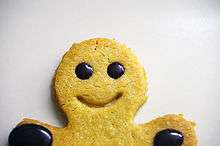Shortcrust pastry
 A shortcrust pastry pie crust | |
| Alternative names | "Shorty" |
|---|---|
| Type | Pastry |
| Main ingredients | Fat (lard, shortening, butter or full-fat margarine), flour, water |
|
| |
Shortcrust pastry is a type of pastry often used for the base of a tart, quiche or pie. It does not puff up during baking because it usually contains no leavening agent. It is possible to make shortcrust pastry with self-rising flour, however. Shortcrust pastry can be used to make both sweet and savory pies such as apple pie, quiche, lemon meringue or chicken pie. Many shortcrust pastries are prepared using vegetable shortening, a fat food product that is solid at room temperature, the composition of which tends to create crumbly, shortcrust-style pastries and pastry crusts.
Proportions
It is based on a "half-fat-to-flour" ratio (by weight). Fat (lard, shortening, butter or full-fat margarine) is rubbed into plain flour to create a loose mixture that is then bound using a small amount of ice water, rolled out, then shaped and placed to create the top or bottom of a flan or pie. Ideally, equal amounts of butter and lard are used to make the pastry, ensuring that the ratio of the two fat products is half that of the flour. The butter is employed to give the pastry a rich flavor, whilst the lard ensures optimum texture.
Types

- Pâte à foncer is French shortcrust pastry that includes egg. Egg and butter are worked together with a small quantity of sugar and salt before the flour is drawn into the mixture and cold water added to bind it.[1]
- Pâte brisée is similar to pâte à foncer, but is lighter and more delicate due to an increased quantity of butter — up to three fifths the quantity of flour.[1]
- Pâte sucrée (sweetcrust pastry, sweet dough, or sweet paste) is made with the addition of sugar, which sweetens the mix and impedes the gluten strands, creating a pastry that breaks up easily in the mouth.
Techniques
In both sweetcrust and shortcrust pastry, care must be taken to ensure that fat and flour are blended thoroughly before liquid is added. This ensures that the flour granules are adequately coated with fat and are less likely to develop gluten and may be achieved with the use of a food processor, a specialized kitchen utensil called a pastry blender, or through various alternatives, like a pair of table knives held in one hand.
Overworking the dough is also a hazard. Overworking elongates the gluten strands, creating a product that is tough, rather than light and crumbly or flaky.
See also
- Food portal
References
- 1 2 Roux, Michel (2010) [First published 2008]. "Shortcrust pastries". Pastry. London: Quadrille Publishing. pp. 20–23. ISBN 978-1-84400-827-8.